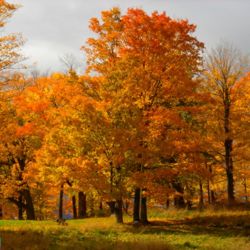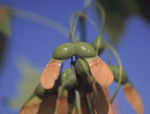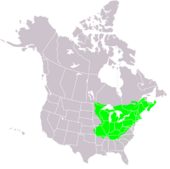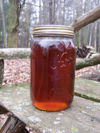Sugar maple
| Sugar maple |
|---|

|
| Scientific Classification |
|
| Species |
|
The Sugar maple is Canada's national tree, as represented by the maple leaf on the Canadian flag. However, it is perhaps best known for providing the sap from which maple syrup is manufactured.
Anatomy
This American maple grows 50 feet to 80 feet in height. The leaves are deciduous, 8-15 cm long. They are about equal in width and have five palmate lobes. The upper lobes of the leaf are larger and notched, and the basal lobes are small. In contrast with the angular notching of the Silver Maple, however, the notches tend to be rounded at their interior. The fall colors range from orange to bright yellow to red-orange. Leaf buds are brown and have a pointy tip. The younger twigs are green, and the will turn dark brown with maturity. The flowers are in corymbs of 5-10 together. They fare yellow-green and without petals. Flowering on the Sugar Maple takes place in early spring, after 30-55 days are spent in a growing process. The Sugar Maple's fruit is a double samara with two winged seeds. The seeds are a globose shape, usually about 6-10 mm diameter, with the wing 2-3 cm long. The seeds fall from the tree in autumn. [1]
Reproduction
The main source of reproduction of the sugar maple is by seed. The sugar maple produces seeds as early as 4 years of age. Trees 12" in diameter are able to produce around 1 million seeds annually. The seeds which are produced are dispersed by way of the wind. Another way in which the Sugar maple reproduces is by germination. Out of the population of seeds, approximately 95% of the seeds, which are viable, are able to germinate in a short time period. This time period is usually around 10 days long. The remaining 5% are usually able to germinate the following year. The reproductive growth includes flowers. The normal time in which this occurs in early spring.
Ecology
The Sugar Maple is a critical plant for the ecology of numbers of forests in America. Sugar Maples are a major component of many different forest types. It is often associated with the American Beech, consequently forming the beech-maple forest type. They also form many other associations such as: Sugar Maple-Yellow Birch, Sugar Maple-White Ash, Sugar Maple-American Basswood and Sugar Maple-Ironwood-Red Oak. They engage in hydraulic lift, which is the process of drawing water from the lower soil layers and removing the same water into upper and more dry soil layers. This benefits both the tree and many other plants growing around it. [2]
Maple in Cuisine
The Sugar Maple and Black Maple are the major sources of sap for making maple syrup. The Sugar Maple is easy to propagate and transplant, and is fairly fast-growing. The maple, however, suffers from the pollution and compacted soils that are regularly found in inner city areas. These conditions make it a frequent victim of maple decline and difficult to grow. Another common problem with growing a Sugar Maple is that the shade and the shallow, fibrous roots may tangle with grass that is growing under the trees. Though fairly dry loam is the best soil for planting maples, the Sugar Maple can also grow well in sandy soil. Poorly drained soils are to be avoided.
The Sugar Maple is regarded as slightly better in its sap production than the Black Maple. Most maples can be used as a source of sap for syrup, but the Sugar and Black Maples are by far the best producers. The Sugar Maples possess one of the hardest woods in the Maple family. It is often used for furniture and flooring. Bowling alleys and bowling pins are both usually made from sugar maple.
Gallery
Related References
- Acer saccharum Native Plant Information Network.
- Acer saccharum Wikipedia
- Sweet, Sticky Science by Emily Sohn. Science News for Kids





